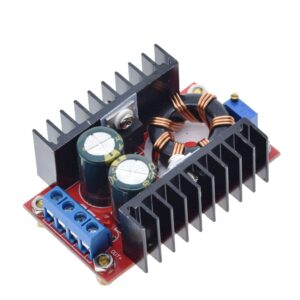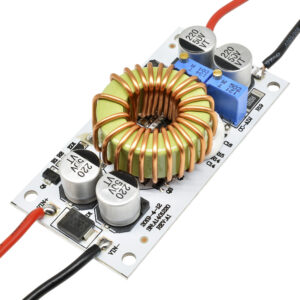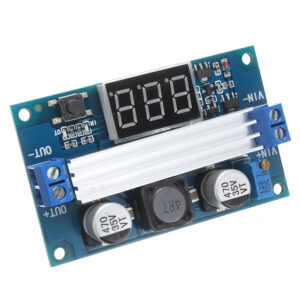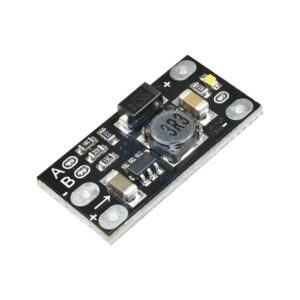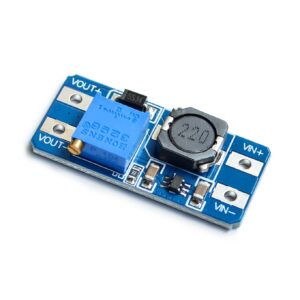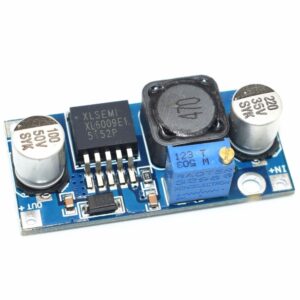Boost Converters
Welcome to our page for Boost Converters! Good quality selection for a variety of options to suit your needs. They are DC to DC Converters that step up voltage. We also offer dedicated Buck Converters and Buck Boost converters.Explore our catalogue to find the perfect solution for your specific requirements.
Showing all 6 results
- £0.99 – £7.90 Select options This product has multiple variants. The options may be chosen on the product page
Showing all 6 results
Boost Converter: Control Voltage Efficiently!
Here at Kunkune, we offer a comprehensive selection to fit your specific needs.
Wide Input Range
Many of our Boost Converters boast a variable input range, typically from 1V to 30V. This flexibility allows you to handle a variety of power sources.
Adjustable or Fixed Output
Choose from Boost Converters with adjustable output voltage for ultimate control, or fixed-voltage models for a simple and reliable solution. We recommend fixed-voltage converters for powering devices with specific requirements like 3.3V, 5V, 9V, or 12V.
Practical Uses of Boost Converters in DIY Electronics
- Arduino Projects: Powering an Arduino board with a 3V battery by stepping up the voltage to 5V.
- LED Lighting: Driving LED strips or individual LEDs at a higher, stable voltage. Select the model with adjustable current to extend the life of LED lights.
- Battery-Powered Devices: Extending battery life by efficiently converting voltage for devices like portable speakers or handheld gadgets.
- RC Vehicles: Regulating voltage for motors and electronic components in remote-controlled cars and drones.
- Solar Power Systems: Optimizing power from solar panels to charge batteries or power devices directly.
- Portable Chargers: Creating custom power banks with multiple output voltages for different devices.
- Home Automation: Powering sensors and microcontrollers in smart home setups from a common lower voltage source.
Benefits of Boost Converters
- Efficiency: High efficiency reduces energy loss and heat generation, making them ideal for battery-powered devices.
- Size Reduction: Smaller components and higher efficiency allow for more compact designs.
- Cost-Effectiveness: Lower energy consumption and reduced need for cooling components lead to cost savings.
Here is some of our boost converters:
- 150W 10A Step-Up Boost Converter Power Supply Module (10-32V to 12-35V)
- Output: Adjustable
- Description: This powerful boost converter can step up voltage from 10-32V to 12-35V with high efficiency, suitable for various power supply needs.
- 250W 10A Boost Converter Step-Up Module (8-48V to 12-50V Adjustable)
- Output: Adjustable
- Description: This robust module offers a wide input range and adjustable output, perfect for high-power applications requiring a voltage boost.
- Mini Fixable Output Voltage Converter Step-Up Module (5V, 8V, 9V, 12V)
- Output: Fixed
- Description: Compact and versatile, this module provides fixed output voltages of 5V, 8V, 9V, and 12V, ideal for small-scale applications.
- MT3608 Boost Converter Adjustable Module
- Output: Adjustable
- Description: Known for its compact size and efficiency, this module is perfect for projects needing an adjustable voltage boost from a low input voltage.
- LCD High Power Adjustable Boost Module 3-35V 100W
- Output: Adjustable
- Description: High-power boost module with an LCD display, offering adjustable output for versatile high-power applications.
What Is a Boost Converter?
A boost converter, also known as a step-up converter, is a type of DC-DC power converter that increases the voltage from its input (source) to its output (load), while stepping down the current, thereby maintaining energy conservation in accordance with the principles of power and energy.
Boost converters play a crucial role in various electronic systems where the input voltage needs to be boosted to meet the requirements of the load. By efficiently increasing the voltage level, these converters enable optimal power transfer and ensure that electronic devices receive the necessary power supply.
One of the key advantages of a boost converter is its ability to provide a stable voltage output even when the input voltage fluctuates. This feature makes it ideal for applications such as battery charging, where a consistent voltage level is essential to ensure fast and safe charging. Boost converters are extensively used in electric vehicles to efficiently manage power flow between the battery and the propulsion system, thereby enhancing the overall performance and energy efficiency.
How Does a Boost Converter Work?
- A step-up converter works by using a combination of circuit components such as an inductor, switch, diode, and capacitor to regulate and increase the input voltage whilst managing current flow and switch states (switch-on and switch-off) to produce a higher output voltage.
What Are the Components of a Boost Converter?
The essential components of a boost converter include the inductor, switch (usually a transistor), diode, and capacitor, which together form the core circuit that enables voltage transformation and regulation.
Each component plays a crucial role in the efficient operation of the boost converter.
- The inductor serves as an energy storage element, storing the electrical energy in its magnetic field during the switch’s on-period. This stored energy is then released to the output during the off-period, boosting the voltage across the load.
- The switch, typically a transistor, controls the current flow by periodically connecting and disconnecting the input voltage to the inductor.
- The diode ensures that the current circulates in a single direction, preventing backflow and directing it towards the output.
- The capacitor acts as a filter, smoothing the output voltage ripples and stabilising the final output signal.
What Are the Applications of Boost Converters?
Boost converters find broad applications in various areas such as:
- battery charging systems
- LED lighting
- solar power systems
- electric vehicles
where they assist in managing voltage levels efficiently and improving the overall performance of these systems.
Battery Charging
In battery charging systems, boost converters are utilised to step up the voltage to the required level for efficient and fast charging, while managing current to avoid overloading the battery.
These boost converters play a crucial role in adjusting voltage and current levels, ensuring that the battery receives the optimal amount of power for its charging cycle. By regulating the energy flow, they help prevent overheating and potential damage to the battery cells.
For instance, in portable electronics like smartphones and laptops, boost converters enable rapid charging by swiftly increasing the voltage supplied to the battery. This technology is also heavily employed in electric vehicles, where the efficiency of the charging process impacts the overall performance and range of the vehicle.
LED Lighting
Boost converters are crucial in LED lighting applications as they provide the necessary voltage boost to achieve optimal brightness and efficiency, ensuring that LEDs operate within their specified voltage and current ranges.
By efficiently increasing the voltage to the required level, boost converters play a vital role in maximising the performance of LED lights. They help manage power supply fluctuations, resulting in a steady flow of current to the LEDs, which not only enhances their luminosity but also extends their lifespan. Residential lighting setups often employ boost converters to maintain consistent illumination levels while minimising energy consumption.
In commercial settings, such as office buildings or retail stores, boost converters are utilised to enhance the overall lighting quality and reduce maintenance costs. They ensure that LEDs receive optimal voltage and current, thereby improving the visual appeal of the space and providing a more comfortable environment for customers and employees alike.
In automotive lighting systems, boost converters are essential for regulating the power supplied to the LEDs, especially in vehicles with varying voltage inputs. These converters help prevent damage to the LEDs and ensure reliable performance, contributing to enhanced safety on the road.
Solar Power Systems
In solar power systems, boost converters are used to increase the voltage from solar panels to match the required levels for energy storage or grid connection, thereby optimising energy conversion efficiency.
These boost converters play a crucial role in ensuring that the electricity generated by solar panels can be effectively stored or utilised in homes, businesses, or fed back into the grid.
By stepping up the voltage output, boost converters allow for efficient energy transfer and distribution, enabling seamless integration of solar power into the existing electrical infrastructure.
Their ability to elevate voltage levels not only enhances energy storage capacities but also contributes to the overall performance, reliability, and longevity of solar power installations.
Electric Vehicles
Boost converters play a pivotal role in electric vehicles by stepping up the battery voltage to meet the high power demands of the vehicle’s motor, thereby improving overall drive efficiency and performance.
Along with this crucial function, boost converters also support regenerative braking systems in electric vehicles. When the vehicle decelerates or brakes, the motor operates in reverse, generating electricity that is fed back into the battery through the boost converter. This process not only helps in slowing down the vehicle but also recharges the battery, enhancing the overall energy efficiency of the vehicle.
What Are the Advantages of Boost Converters?
Boost converters offer several advantages including:
- High efficiency in energy conversion
- Compact size that makes them suitable for portable devices
- The ability to operate over a wide input voltage range, making them versatile for various applications
High Efficiency
One of the primary advantages of boost converters is their high efficiency, which ensures that a maximum amount of input power is converted to useful output power with minimal energy losses.
This high efficiency is achieved through a combination of factors. The utilisation of advanced semiconductor technology allows boost converters to operate with reduced switching losses and improved thermal performance. The optimised circuit design plays a crucial role in minimising energy dissipation and ensuring stable operation.
For instance, in the automotive industry, efficient boost converters are essential for powering electric vehicle components, where every bit of energy matters for extending driving range and performance. Similarly, in renewable energy systems, such as solar inverters, the efficiency of boost converters impacts overall system performance and energy yield.
Compact Size
The compact size of boost converters makes them ideal for integration into portable electronic devices, where space is limited, and efficient power conversion is essential.
These compact devices offer significant advantages in terms of power efficiency and performance. The small form factor allows them to be easily embedded into the tight spaces of smartphones, tablets, wearable devices, and other portable gadgets. Their size also reduces weight, making them ideal for products that prioritize mobility and convenience.
Design considerations play a crucial role in ensuring the compactness of boost converters. Engineers often opt for high-frequency switching circuits to minimise the size of passive components like inductors and capacitors. The use of advanced components, such as integrated power stages and multi-level converter topologies, further contributes to the overall reduction in size without compromising efficiency.
Wide Input Voltage Range
Boost converters can operate over a wide input voltage range, providing flexibility and adaptability for various applications, from low-voltage battery systems to higher voltage power supplies.
This wide input voltage range is a crucial feature that allows boost converters to efficiently step up or boost the voltage across a wide spectrum of hardware setups.
Whether it’s in renewable energy systems, portable electronics, or automotive applications, the ability of boost converters to handle varying input voltages ensures reliable performance in diverse scenarios.
What Are the Disadvantages of Boost Converters?
Despite their many advantages, boost converters also have some disadvantages, including limited output power capability and the complexity of circuit design, which can pose challenges in certain applications.
Limited Output Power
Boost converters typically have limited output power, which can restrict their use in applications requiring high power levels, such as industrial machinery or large-scale renewable energy systems.
One of the primary reasons behind the output power limitations of boost converters is the voltage stress that occurs across the components during the boosting process. As the input voltage is boosted to a higher level, the stress on the components, particularly the switches and capacitors, increases significantly, leading to potential reliability issues and reduced efficiency.
The high currents flowing through the components in boost converters also contribute to power limitations. These high currents can result in increased power losses due to resistive elements in the components, further capping the maximum power output that the converter can deliver efficiently.
Complex Circuit Design
The circuit design of boost converters can be complex, requiring precise coordination of multiple components such as inductors, switches, diodes, and capacitors, which can increase design time and cost.
One of the key challenges in designing a boost converter circuit lies in selecting the right components that not only meet the desired specifications but also interact seamlessly. Proper layout considerations are crucial to ensure optimal performance and efficiency. Integrating these components effectively into the circuit design can be a daunting task, as each element plays a critical role in the overall functionality. Engineers often face trade-offs between component cost, size limitations, and efficiency targets, requiring a delicate balance to achieve the desired outcomes.
How to Choose the Right Boost Converter for Your Application?
Choosing the right boost converter for your application involves considering several factors such as input and output voltage requirements, output power demands, efficiency ratings, size and form factor, as well as the overall cost.
Input and Output Voltage Requirements
When selecting a boost converter, it’s crucial to match the input and output voltage requirements of your application to ensure optimal performance and efficiency.
Failure to accurately determine the voltage needs of your system could lead to inefficiencies, component damage, or even system failure. Voltage compatibility is key in avoiding these potential pitfalls.
For example, in an automotive application, if the voltage requirements of a certain electronic component aren’t met, it could result in erratic behavior or malfunctioning. On the other hand, in a renewable energy system, a mismatch in voltage could lead to decreased energy conversion efficiency.
Output Power Requirements
Assessing the output power requirements is essential when choosing a boost converter, as it must be capable of delivering sufficient power to meet the demands of your application without exceeding its limitations.
Calculating the necessary output power involves considering the voltage and current requirements of the load, as well as any efficiency losses in the system. Ensuring the converter can handle peak power demands while maintaining stability is crucial.
Power demands influence converter selection, as different applications have varied power needs. For instance, high-power applications like electric vehicles or industrial machinery require converters with high power ratings to support intense loads. On the other hand, low-power applications such as sensors or small electronic devices can utilise converters with lower power outputs to conserve energy efficiently.
Efficiency Ratings
Efficiency ratings are a critical factor in selecting a boost converter, as higher efficiency translates to better power conversion and less energy loss.
Understanding efficiency ratings involves looking at how effectively the boost converter can convert input power to output power. The efficiency rating is usually given as a percentage, indicating the ratio of output power to input power. A higher percentage means less energy is wasted during the conversion process.
High-efficiency converters are essential in minimising energy waste, especially in applications like renewable energy systems, electric vehicles, and portable electronics where power consumption needs to be optimised for longer battery life and reduced environmental impact.
Size and Form Factor
The size and form factor of a boost converter are important considerations, especially in applications where space is limited and compact design is desirable.
Designing a boost converter that strikes the right balance between size and efficiency is crucial in various electronics applications. By opting for a more compact form factor, engineers can enhance portability and flexibility without compromising on performance. For instance, in wearable devices like fitness trackers and smartwatches, a small boost converter is essential to ensure long battery life and convenience for the user. Miniaturised boost converters find extensive use in IoT devices, where space constraints are prevalent but power efficiency cannot be sacrificed.
Cost
Cost is a significant factor when selecting a boost converter, as it must fit within the budget constraints of your project whilst still delivering the required performance.
When considering cost versus performance, it’s crucial to strike a balance that meets your project’s needs without overspending. The total cost of ownership is another key aspect to keep in mind, as it includes not only the initial purchase price but also maintenance, energy consumption, and potential future upgrades.
- For applications where space is limited, compact and cost-efficient boost converters like the LM27313 by Texas Instruments could be ideal.
- On the other hand, in high-power applications, the LT8362 by Analog Devices offers a good balance between cost and performance.
By carefully analysing these factors, you can ensure you choose a boost converter that not only fits your budget but also delivers the required performance over the long term.

